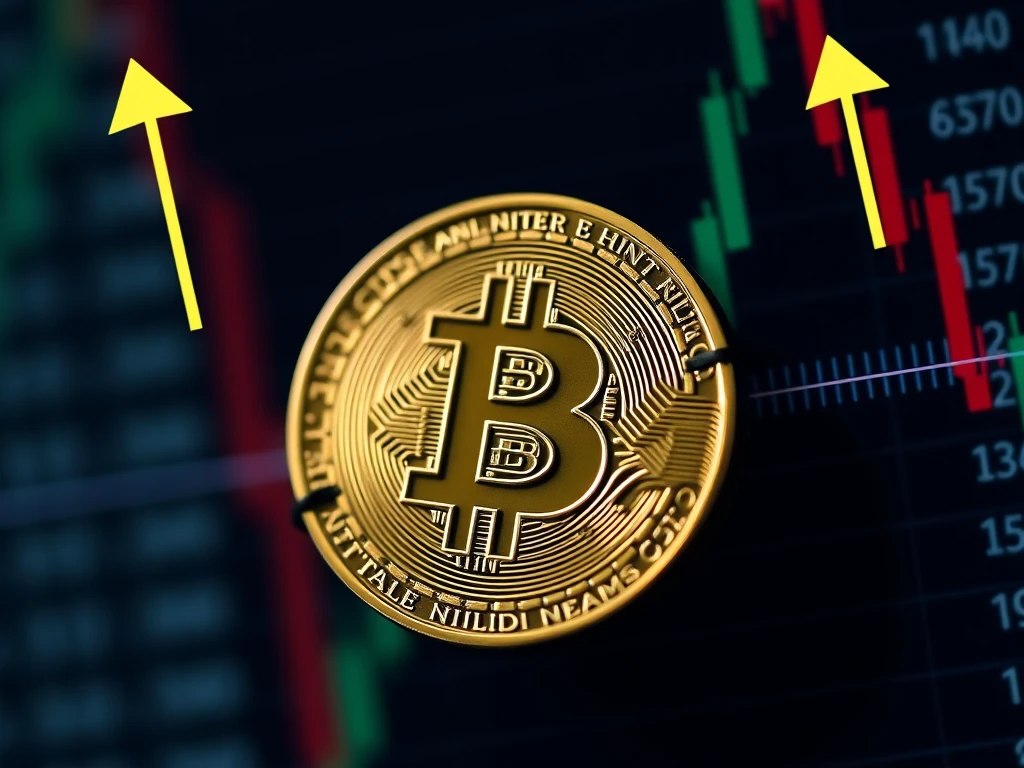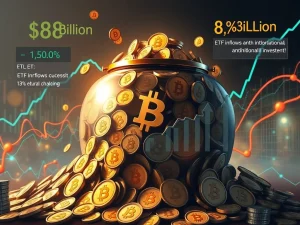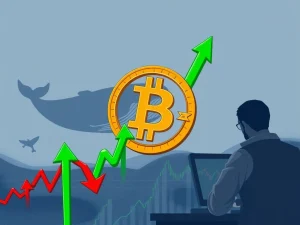Bitcoin’s Price Consolidation: When Will This Sideways Trend Finally End?

Bitcoin (BTC) has been in a period of price consolidation, leaving investors and traders wondering: How long will Bitcoin’s price consolidation last? Since March 11, the leading cryptocurrency has been trading within a range of $76,600 to $87,500. This sideways movement has sparked intense speculation about when Bitcoin will finally break free and resume its upward or downward trajectory. Data suggests that this phase of indecision, reflected in neutral funding rates, might persist for a while longer. Let’s delve into the factors influencing this consolidation and explore potential breakout scenarios based on expert Bitcoin analysis.
Bitcoin Price Consolidation Deep Dive: What’s Happening?
Since mid-March, Bitcoin’s price action has been characterized by choppy trading, lacking a clear directional bias. As market analyst Daan Crypto Trades pointed out on X, Bitcoin has failed to establish a consistent series of green or red candles on the daily chart. This lack of momentum signifies the ongoing Bitcoin price consolidation. The price is currently “in the middle of nowhere,” as analysts describe it, neither decisively bullish nor bearish. This state of equilibrium leaves many questioning the duration and potential outcome of this phase.
$90,000: The Crucial Level for Bitcoin Price Breakout
According to several analysts, reclaiming the $90,000 level is critical to ending the current Bitcoin price consolidation. Daan Crypto Trades suggests that regaining this mark would signal a return of bullish sentiment and momentum. A successful move above $90,000 could pave the way for new all-time highs relatively quickly. However, failure to breach this resistance level could lead to a retest of lower support levels, potentially revisiting the $73,000 – $74,000 range, which analysts believe should offer some support. Jelle echoes this sentiment, emphasizing that breaking above $90,000 is essential to reignite a strong bullish outlook.
Bitcoin Analysis: Examining Key Technical Indicators
Further Bitcoin analysis from Rekt Capital highlights the significance of the 21-week exponential moving average (EMA). For a confirmed breakout, Bitcoin needs to achieve a weekly close above the 21-week EMA, currently around $88,400. This level acts as resistance within a triangular market structure formed by the 21 and 50 EMAs. A successful weekly close above $88,400, followed by a retest to confirm support, could signal a move towards $93,500. Rekt Capital draws parallels to 2021 price action, where a similar pattern around the 21-week EMA preceded a significant upward movement. Here’s a breakdown of key price levels to watch:
- Key Resistance: $90,000 (Daily Chart), $88,400 (Weekly Close – 21-week EMA)
- Potential Support Retest: $73,000 – $74,000 range
- Breakout Target (if $88,400 & $90,000 reclaimed): $93,500 and potentially new highs
Funding Rates and Their Impact on Bitcoin Price
Another crucial aspect of Bitcoin analysis during this consolidation phase is the funding rate in perpetual futures markets. Funding rates are periodic payments between long and short traders, reflecting market sentiment. Currently, Bitcoin funding rates are hovering around 0%. This neutral level indicates indecisiveness in the market; neither bulls nor bears are dominant enough to command a premium.
Impact of Neutral Funding Rates:
| Funding Rate Condition | Market Sentiment | Price Action Implication |
|---|---|---|
| Positive Funding Rates | Bullish Sentiment (Longs pay Shorts) | Increased pressure on longs, potential for pullbacks |
| Negative Funding Rates | Bearish Sentiment (Shorts pay Longs) | Increased pressure on shorts, potential for rallies |
| Neutral Funding Rates (around 0%) | Indecisiveness, Balanced Market | Reduced pressure on both sides, dampening volatility, potential for continued consolidation |
Zero funding rates minimize the cost of holding positions, reducing the urgency for traders to exit. This can stabilize Bitcoin’s price in the short term, contributing to the ongoing Bitcoin price consolidation. However, it also creates a potential setup for a significant move in either direction, as accumulated positions can amplify volatility once a breakout occurs. QCP Capital notes that despite a recent rebound above $85,000, “funding rates remain flat,” maintaining a cautious outlook on the prospects for an immediate sustained breakout.
Bollinger Bands Signal Potential Bitcoin Price Breakout
While funding rates suggest continued consolidation, another technical indicator, Bollinger Bands, hints at a potential end to this phase. Tightening Bollinger Bands are often seen as a precursor to significant price movements. The weekly Bollinger Bandwidth for Bitcoin is currently extremely tight, comparable to levels seen between July and October 2024, and June to September 2023.
Historical Bollinger Band Squeeze and Subsequent Rallies:
- July – October 2024: Consolidation between $63,000 and $69,000 preceded a 60% rally to $106,000 (previous 2024 high).
- June – September 2023: Tight Bollinger Bands preceded a 176% rally to $73,800 (March 2024 high).
If history repeats, the current tightening of Bollinger Bands could indicate that Bitcoin price breakout is imminent, potentially unfolding over the coming weeks. This anticipation of a breakout adds another layer of intrigue to the current market situation.
Conclusion: Navigating Bitcoin’s Consolidation Phase
Bitcoin’s price consolidation continues as the market awaits a clear catalyst for a breakout. Bitcoin analysis of funding rates suggests ongoing indecision, while tightening Bollinger Bands hint at a potential resolution on the horizon. Key levels to watch remain $90,000 for an upside breakout and the $73,000 – $74,000 range for potential support retests. Traders should closely monitor these indicators and price levels to anticipate the end of this consolidation phase and the beginning of Bitcoin’s next significant move. Remember, every investment carries risk, and thorough research is crucial before making any decisions in the volatile cryptocurrency market.









